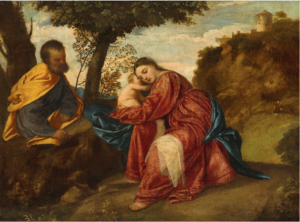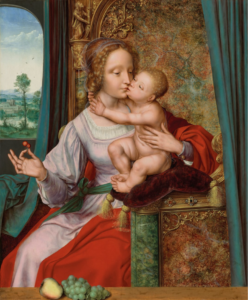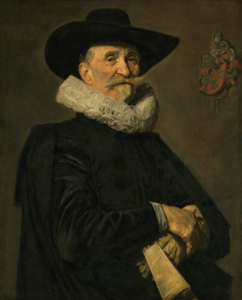
The Rest on the Flight into Egypt by Titian
This week, many of the main London auction houses will be hosting a variety of sales focusing on the art of the old Masters. Christie’s kicked everything off on Tuesday, July 2nd, with a duo of auctions. The morning sale focusing on prints did fairly well, but it was the later evening sale that drew everyone’s attention. Of the twenty-four lots available, much of the art world press focused on what eventually became the star of the sale: The Rest on the Flight into Egypt by Titian.
The painting is one of the artist’s first great works, created sometime around 1512 when he was likely still studying in the studios of Gentile and Giovanni Bellini. It shows a biblical scene popular among European artists, where Mary and Joseph take the newborn Jesus and flee to Egypt to escape the Massacre of the Innocents ordered by King Herod. Showing the Holy Family in a moment of brief rest during the flight into Egypt became popular during the Renaissance, with artists like Caravaggio, Rembrandt, and Van Dyck all tackling the subject. Rest on the Flight into Egypt has an impressive provenance, including European nobility and royalty. It has also been stolen on two occasions, first from the Belvedere Palace in Vienna during the Napoleonic Wars. The second theft occurred in 1995 when thieves took the painting from Longleat House in Wiltshire. Longleat is an estate owned by the Thynne family, who hold the title Marquess of Bath. Seven years after the theft, a former Scotland Yard officer finally recovered the Titian, receiving a tip and locating the painting in a plastic bag at a bus stop in London. The sale at Christie’s on Tuesday marked the first time the painting appeared at auction since the Thynne family first purchased it in 1878. Andrew Fletcher, Christie’s global head of Old Masters, called it “the most important work by Titian to come to the auction market in more than a generation”. Christie’s assigned it an estimate of £15 million and £25 million. However, despite its impressive provenance and the media attention, the Titian received few bids, just enough to get it to its minimum estimate of £15 million / $19 million (or £17.56 million / $22.26 million w/p). This set a new auction record for a Titian painting, which was previously set at Sotheby’s in 2011 when the painting A Sacra Conversazione sold for $16.88 million w/p.

Madonna of the Cherries by Studio of Quentin Metsys
Next was another religious painting, one of the three Madonna & Child paintings available on Tuesday. This one bears the title of Madonna of the Cherries from the studio of the Antwerp Renaissance painter Quentin Metsys. The Madonna of the Cherries was a popular subject during the Renaissance, with the original version first created by Leonardo da Vinci. A version of the subject by Metsys’s contemporary Joos van Cleve sold for £80K hammer in April 2022 during a Sotheby’s Old Masters online sale. The Metsys studio rendition offered at Christie’s on Tuesday last sold in 2015 for £254.5K w/p. However, in the nine years since its last appearance at auction, some restoration work has been done. Not only are the painting’s colors brighter, but the restoration also revealed that a later artist painted a sheer green drape over the window in the background. With that gone, the trees, clouds, and birds in flight that the curtain once obscured are now visible. With Christie’s specialists assigning it an estimate of between £8 million and £12 million, the Madonna of the Cherries eventually hammered at £9 million / $11.4 million (or £10.66 million / $13.5 million w/p), with the Getty Museum in Los Angeles reported as the buyer. Like the Titian, this was another auction record for the artist, with the previous record held by a painting sold in 2020 for $1.9 million w/p. However, with such a high estimate and a final price, it seems interesting that the Madonna of the Cherries is attributed to the artist’s studio rather than the artist himself. It may indicate that the Getty Museum or any future owner may bump up the attribution to just the artist, omitting the studio altogether to justify the large sum of money paid.
And finally, moving away from the religious works, the sale’s third place was a portrait by one of the best of the Old Masters in that genre, Frans Hals. Portrait of a Gentleman of the de Wolff Family is a half-length portrait of an older man with a ruff and a large-brimmed hat. The portrait’s subject is unknown, with several theories circulating among our historians for over a century. The coat of arms in the upper right-hand corner certainly helps, as it shows wolves’ heads against a red background. This has led some to deduce that he was a member of the de Wolff family, possibly the cloth merchant Joost de Wolff. The Hals portrait hammered within its £4 million to £7 million, selling for £4.7 million / $5.9 million (or £5.7 million / $7.2 million w/p).

Portrait of a Gentleman of the de Wolff Family by Frans Hals
Surprises are rare in sales like this since they feature a relatively small number of higher-value lots. However, a couple of lots managed to sell far above their initial estimates Christie’s gave them. First, there was Sir Peter Lely’s Portrait of Barbara Villiers. The subject was a prominent noblewoman in seventeenth-century England. She held the titles Countess of Castlemaine and Duchess of Cleveland, later appointed as Queen Catherine’s Lady of the Bedchamber, and was even one of King Charles II’s mistresses. Expected by Christie’s specialists to sell for no more than £180K, the Lely portrait hammered at £450K, or two-and-a-half times its high estimate. Then, there was Pieter Coecke van Aelst’s 1530 painting Saint Jerome in His Study. While depictions of Saint Jerome often show him as an ascetic living in the wilderness, Van Aelst’s Saint Jerome is a scholar and the compiler of the Vulgate Bible. Van Aelst retains the inclusion of a skull in the painting, a popular component of Saint Jerome’s iconography as a symbol of mortality, but otherwise decorates the saint’s study with a cardinal’s hat, candles, books, a clock, and other items. Christie’s expected the painting to sell for a maximum of £200K, yet it eventually sold for £540K / $684.6K (or £680.4K / $862.6K w/p).
Despite the success of most of the high-value lots, Christie’s could have done better. Seven of the twenty-four lots available on Tuesday sold within their estimates, giving Christie’s a 29% accuracy rate. Only four lots (17%) failed to sell, leaving the auction with an 83% sell-through rate. Seven lots (29%) sold below estimate, while six (25%) sold above. However, among the four that went unsold was George Stubbs’s Mares and Foals in an Extensive Landscape. It is one of the most prominent paintings from the artist’s series of works on the subject, measuring nearly six by nine feet. Christie’s, therefore, assigned it a hefty estimate range of £7 million to £10 million. While the Stubbs received a few bids, interest ran out at £6.5 million. With the Stubbs failing to sell, the auction could not make its presale estimate minimum of £41.4 million. The twenty-four lots offered at Christie’s brought in £36.4 million / $46.2 million.
Christie’s Old Masters
The Rest on the Flight into Egypt by Titian
This week, many of the main London auction houses will be hosting a variety of sales focusing on the art of the old Masters. Christie’s kicked everything off on Tuesday, July 2nd, with a duo of auctions. The morning sale focusing on prints did fairly well, but it was the later evening sale that drew everyone’s attention. Of the twenty-four lots available, much of the art world press focused on what eventually became the star of the sale: The Rest on the Flight into Egypt by Titian.
The painting is one of the artist’s first great works, created sometime around 1512 when he was likely still studying in the studios of Gentile and Giovanni Bellini. It shows a biblical scene popular among European artists, where Mary and Joseph take the newborn Jesus and flee to Egypt to escape the Massacre of the Innocents ordered by King Herod. Showing the Holy Family in a moment of brief rest during the flight into Egypt became popular during the Renaissance, with artists like Caravaggio, Rembrandt, and Van Dyck all tackling the subject. Rest on the Flight into Egypt has an impressive provenance, including European nobility and royalty. It has also been stolen on two occasions, first from the Belvedere Palace in Vienna during the Napoleonic Wars. The second theft occurred in 1995 when thieves took the painting from Longleat House in Wiltshire. Longleat is an estate owned by the Thynne family, who hold the title Marquess of Bath. Seven years after the theft, a former Scotland Yard officer finally recovered the Titian, receiving a tip and locating the painting in a plastic bag at a bus stop in London. The sale at Christie’s on Tuesday marked the first time the painting appeared at auction since the Thynne family first purchased it in 1878. Andrew Fletcher, Christie’s global head of Old Masters, called it “the most important work by Titian to come to the auction market in more than a generation”. Christie’s assigned it an estimate of £15 million and £25 million. However, despite its impressive provenance and the media attention, the Titian received few bids, just enough to get it to its minimum estimate of £15 million / $19 million (or £17.56 million / $22.26 million w/p). This set a new auction record for a Titian painting, which was previously set at Sotheby’s in 2011 when the painting A Sacra Conversazione sold for $16.88 million w/p.
Madonna of the Cherries by Studio of Quentin Metsys
Next was another religious painting, one of the three Madonna & Child paintings available on Tuesday. This one bears the title of Madonna of the Cherries from the studio of the Antwerp Renaissance painter Quentin Metsys. The Madonna of the Cherries was a popular subject during the Renaissance, with the original version first created by Leonardo da Vinci. A version of the subject by Metsys’s contemporary Joos van Cleve sold for £80K hammer in April 2022 during a Sotheby’s Old Masters online sale. The Metsys studio rendition offered at Christie’s on Tuesday last sold in 2015 for £254.5K w/p. However, in the nine years since its last appearance at auction, some restoration work has been done. Not only are the painting’s colors brighter, but the restoration also revealed that a later artist painted a sheer green drape over the window in the background. With that gone, the trees, clouds, and birds in flight that the curtain once obscured are now visible. With Christie’s specialists assigning it an estimate of between £8 million and £12 million, the Madonna of the Cherries eventually hammered at £9 million / $11.4 million (or £10.66 million / $13.5 million w/p), with the Getty Museum in Los Angeles reported as the buyer. Like the Titian, this was another auction record for the artist, with the previous record held by a painting sold in 2020 for $1.9 million w/p. However, with such a high estimate and a final price, it seems interesting that the Madonna of the Cherries is attributed to the artist’s studio rather than the artist himself. It may indicate that the Getty Museum or any future owner may bump up the attribution to just the artist, omitting the studio altogether to justify the large sum of money paid.
And finally, moving away from the religious works, the sale’s third place was a portrait by one of the best of the Old Masters in that genre, Frans Hals. Portrait of a Gentleman of the de Wolff Family is a half-length portrait of an older man with a ruff and a large-brimmed hat. The portrait’s subject is unknown, with several theories circulating among our historians for over a century. The coat of arms in the upper right-hand corner certainly helps, as it shows wolves’ heads against a red background. This has led some to deduce that he was a member of the de Wolff family, possibly the cloth merchant Joost de Wolff. The Hals portrait hammered within its £4 million to £7 million, selling for £4.7 million / $5.9 million (or £5.7 million / $7.2 million w/p).
Portrait of a Gentleman of the de Wolff Family by Frans Hals
Surprises are rare in sales like this since they feature a relatively small number of higher-value lots. However, a couple of lots managed to sell far above their initial estimates Christie’s gave them. First, there was Sir Peter Lely’s Portrait of Barbara Villiers. The subject was a prominent noblewoman in seventeenth-century England. She held the titles Countess of Castlemaine and Duchess of Cleveland, later appointed as Queen Catherine’s Lady of the Bedchamber, and was even one of King Charles II’s mistresses. Expected by Christie’s specialists to sell for no more than £180K, the Lely portrait hammered at £450K, or two-and-a-half times its high estimate. Then, there was Pieter Coecke van Aelst’s 1530 painting Saint Jerome in His Study. While depictions of Saint Jerome often show him as an ascetic living in the wilderness, Van Aelst’s Saint Jerome is a scholar and the compiler of the Vulgate Bible. Van Aelst retains the inclusion of a skull in the painting, a popular component of Saint Jerome’s iconography as a symbol of mortality, but otherwise decorates the saint’s study with a cardinal’s hat, candles, books, a clock, and other items. Christie’s expected the painting to sell for a maximum of £200K, yet it eventually sold for £540K / $684.6K (or £680.4K / $862.6K w/p).
Despite the success of most of the high-value lots, Christie’s could have done better. Seven of the twenty-four lots available on Tuesday sold within their estimates, giving Christie’s a 29% accuracy rate. Only four lots (17%) failed to sell, leaving the auction with an 83% sell-through rate. Seven lots (29%) sold below estimate, while six (25%) sold above. However, among the four that went unsold was George Stubbs’s Mares and Foals in an Extensive Landscape. It is one of the most prominent paintings from the artist’s series of works on the subject, measuring nearly six by nine feet. Christie’s, therefore, assigned it a hefty estimate range of £7 million to £10 million. While the Stubbs received a few bids, interest ran out at £6.5 million. With the Stubbs failing to sell, the auction could not make its presale estimate minimum of £41.4 million. The twenty-four lots offered at Christie’s brought in £36.4 million / $46.2 million.